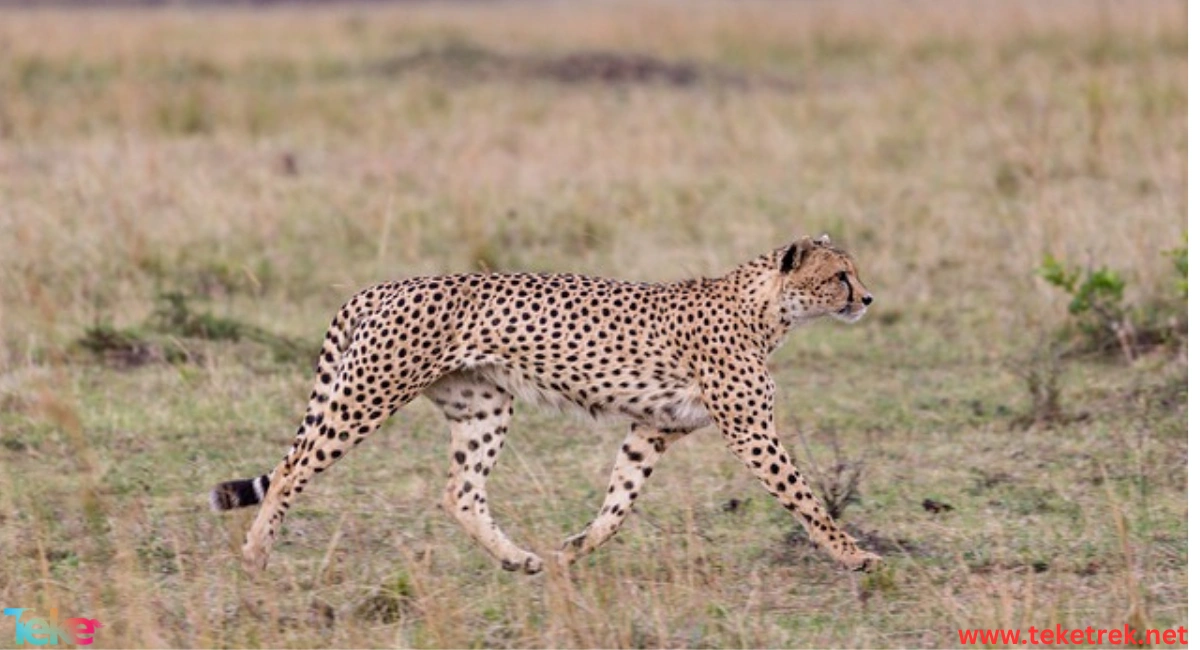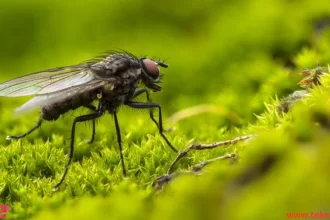The cheetah is considered the fastest land animal, but it has weak points in its structure when compared to its family members. It belongs to the feline family, and its scientific name is *Acinonyx jubatus*.
Let’s learn more about it from teketrek.

Key characteristics of the cheetah:
– The cheetah has a sleek body, deep chest, narrow waist, and long legs, which give it exceptional speed.
– Its fur is coarse and short, with small, evenly spaced dark spots ranging from 2 to 3 centimeters in diameter on a yellow or creamy-white background.
– These spots help it blend into the surrounding environment, making it easier to hunt and providing complete camouflage. The spots cover the entire body except for the lower part, which is entirely white. The spots also merge into rings on the tail, forming between 4 and 6 dark circles. The tail usually ends with a white tuft.
Black tear trails run from the corners of his eyes along his nose to his mouth, shielding his eyes from the glare of the sun during the hunt.
– The cheetah has a round face with large ears, a short nose, and large eyes that aid in night vision. The cheetah’s head is small vs to its body.
– The cheetah’s length ranges from 112 to 135 centimeters, while its tail adds approximately 84 centimeters. The long tail helps maintain balance during sharp turns.
– Its weight varies between 21 and 72 kilograms, with males slightly larger than females.
The cheetah superficially resembles the leopard, but the leopard has a larger head, retractable claws, circular rosettes instead of spots, and lacks tear tracks. Additionally, the cheetah is taller than the leopard.
How fast can a cheetah run?
Cheetahs are the fastest mammals, reaching speeds between 80 and 98 kilometers per hour or more. They can maintain this speed for about 275 meters.
Cheetahs take approximately 7 to 8 meters in a single stride and cover 4 strides per second.
It is rare for cheetahs to run more than 400 meters due to the risk of overheating. After each hunt, they rest briefly before resuming their activities.
The physiological reasons for the cheetah’s speed include:
1. Longer leg bones and a more extended spine than the thigh and shoulder.
2. A small head and a long spine, providing flexibility and speed.
3. Relatively long and slender bones, especially in the limbs and pelvis, aiding control and speed.
4. Cold noses that allow them to take in large amounts of air and dissipate body heat.
5. A high proportion of fast-twitch muscle fibers, enhancing their speed and agility.
Habitats and distribution:
Cheetahs inhabit a variety of regions in Africa, including southern Africa and central Iran. They thrive in open areas such as grassy plains, savannas, arid lands, and mountainous desert terrains. Southern and eastern Africa are crucial regions for cheetahs, but they can also be found in parts of northern Africa.
Why is the cheetah called “jita”?
The English name “cheetah” is derived from the ancient Indian language, where “چیتا” (Cītā) means “swift” or “fast-moving.” It also translates to “spotted body.” This term aptly describes the cheetah’s incredible speed and agility during hunting.
Recognized cheetah subspecies:
Acinonyx jubatus jubatus (South African cheetah):
Mainly found in southern Africa and parts of eastern Africa, including Angola, Botswana, Congo, Mozambique, Malawi, South Africa, Tanzania, Zambia, Zimbabwe, and Namibia. There are 500 individuals left in the wild.
Acinonyx jubatus raineyii(East African cheetah or Maasai cheetah):
Inhabits East Africa and the Horn of Africa, including Kenya, Somalia, Tanzania, and Uganda. Around 3,000 individuals survive.
Acinonyx jubatus velox (Northwest African cheetah):
Occurs in parts of West Africa.
Acinonyx jubatus ngorongorensis (Ngorongoro cheetah):
Found in Tanzania, specifically in the Ngorongoro Crater.
Acinonyx jubatus soemmeringii(Central African cheetah):
Lives in several Central African countries and parts of northern Africa, including Cameroon, Chad, Central African Republic, Ethiopia, Nigeria, Niger, and Sudan.
Certainly! Here’s the translation of the information you provided about cheetahs:
Heck’s Cheetah
(North African Cheetah, Saharan Cheetah, Acinonyx jubatus hecki):**
– This subspecies inhabits North and West Africa, specifically in countries such as Algeria, Djibouti, Egypt, Mali, Mauritania, Morocco, Niger, Tunisia, Libya, Benin, Burkina Faso, Ghana, and Senegal.
– It is critically endangered, with some estimates suggesting there are fewer than 250 adult cheetahs remaining in the wild.
Hunting Cheetah
(Asian Cheetah, Iranian Cheetah, Indian Cheetah, Arabian Cheetah, Acinonyx jubatus venaticus):
– This subspecies had a wider distribution, including parts of the Arabian Peninsula (Oman, United Arab Emirates, Saudi Arabia, Iraq, Jordan, Palestine, Lebanon, and Syria). It also extended to Turkey, Iran, Pakistan, Afghanistan, India, Armenia, Azerbaijan, Turkmenistan, and parts of Russia.
– It is also critically endangered, with estimates suggesting there are around 50 wild cheetahs remaining. Their current range is limited to Iran, parts of Pakistan, and Oman.
Regarding hybridization, it is challenging to hybridize cheetahs with other large felids due to their smaller size and less aggressive behavior compared to other big cat species.
Reproduction:
Female cheetahs reach sexual maturity at around 2 to 3 years, while male cheetahs mature at around 1 year. However, males do not typically mate before the age of 3.
Cheetahs can mate throughout the year, but births peak during the rainy season.
The gestation period for cheetahs is 90 to 98 days, and females give birth to 3 to 5 cubs.
Cubs are weaned at around 4 months and start learning hunting skills from their mother. By 1.5 years, they become independent and establish their own territories.
Diet:
Cheetahs primarily feed on small animals weighing less than 40 kilograms, such as young deer, gazelles, piglets, wild rabbits, foxes, and some birds.
Unlike most other big cats that are nocturnal, cheetahs are active during early mornings or evenings, relying more on their vision than their sense of smell.
Vocalizations:
– Cheetahs have a variety of vocalizations:
Chirping:
Short calls resembling bird sounds, used for excitement or to gather around a kill or lost cubs.
Charring:
A sharp, staccato call similar to a bird’s chirp, used during feeding or communication among adult cheetahs.
Purring:
Similar to domestic cat purring but higher-pitched, expressing contentment or greeting others.
Aggressive Sounds:
These sounds include growling, coughing, hissing, groaning, and howling. Growling indicates distress, while coughing, hissing, and moaning are accompanied by forceful paw strikes on the ground. Cubs may emit a high-pitched “mew” during play or when hungry.
Other Sounds:
Cheetahs also make friendly chuffing sounds during interactions and use repetitive calls like “ihn ihn” to gather cubs or “prr prr” to guide them during travels. Low-toned warning calls signal cubs to stay calm, while louder calls indicate disputes.

The most frequently asked questions about the cheetah.
- What is the difference between a tiger and a cheetah?
Tigers are larger and heavier than cheetahs and have a more aggressive nature. They usually hunt in groups and live in forests, while cheetahs hunt alone and live in grasslands. Tigers have stripes on their fur, while cheetahs have spots. Cheetahs are much faster runners than tigers
- How fast is the king cheetah?
The speed of the cheetah ranges between 112 and 120 kilometers per hour (between 70 and 75 miles per hour), in short distances up to 460 meters (1,510 feet), and it has the ability to reach a speed of 103 kilometers per hour from zero in just 3 seconds, and this makes it Faster than most supercars.
- How long does a female cheetah give birth?
The female gives birth to a litter of between 3 and 5 individuals, although it may reach 9, after a gestation period lasting between 90 and 98 days.
- Is the cheetah a predator?
Yes, the cheetah is a predator.
- Who is stronger, the lion, the tiger, or the cheetah?
The tiger is stronger.
- What is the food of a cheetah?
Cheetahs are omnivores, and feed mostly on herbivores such as gazelles, hares and larger animals such as zebras and Barbary ostriches. On a few occasions, deer are their favorite prey and this causes a shortage of gazelle numbers in the North-East African region.
In conclusion, cheetahs face numerous threats, including habitat loss, illegal hunting, and susceptibility to diseases. As of 2016, there were approximately 7,100 cheetahs in the wild worldwide, but this estimate can vary due to changes in natural habitats and threats faced by these animals.
المصادر





